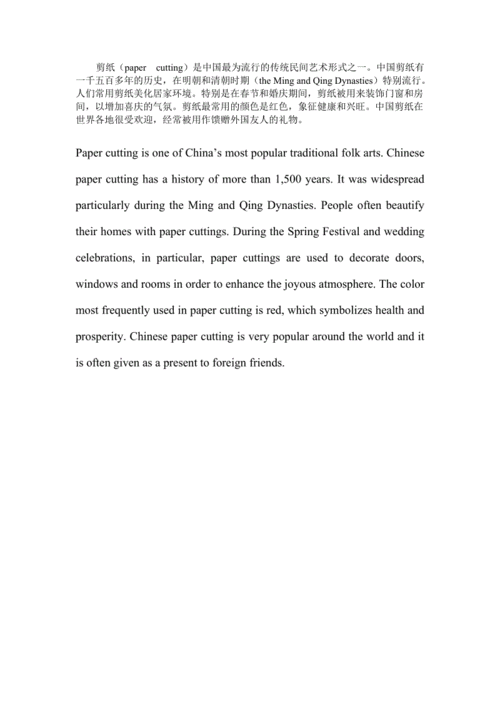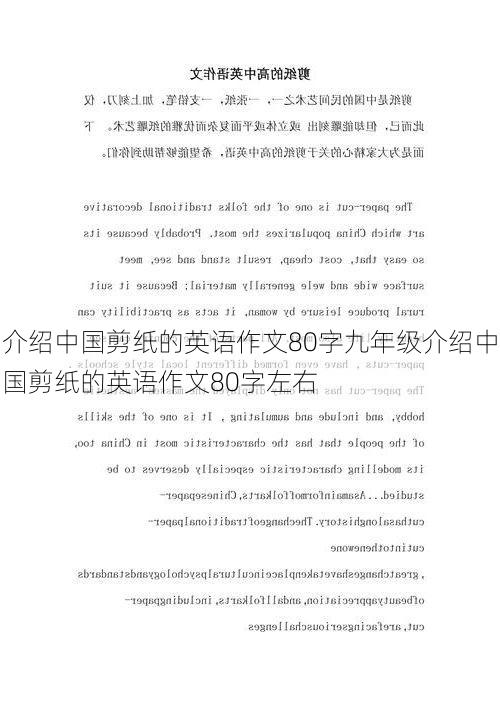Introducing the Art of Chinese Paper Cutting
Chinese paper cutting, also known as jianzhi, is a fascinating and intricate art form with a rich history spanning over two millennia. As a traditional folk art, it holds a special place in Chinese culture, reflecting the country's long-standing artistic heritage and deeply rooted cultural values.

A Journey Through Time:
The origins of paper cutting can be traced back to the Han Dynasty (206 BC - 220 AD), a period marked by significant advancements in papermaking. Early forms of paper cutting were primarily used for decorative purposes, adorning windows, walls, and lanterns during festivals and special occasions. As the art evolved, its applications expanded to include religious ceremonies, weddings, and other significant life events.
The Art of Precision and Symbolism:
Chinese paper cutting is characterized by its delicate precision and intricate designs. Artists employ scissors or knives to create intricate patterns and motifs from a single sheet of paper, often utilizing symmetrical designs and vibrant colors. The art form is not merely about visual aesthetics; it is deeply rooted in symbolism and storytelling.
Each cut represents a specific meaning, often drawing inspiration from Chinese folklore, mythology, and traditional beliefs. For instance, a phoenix symbolizes prosperity and happiness, while a dragon represents strength and good fortune. The intricate patterns and symbolic representations make paper cutting a unique and powerful form of visual communication.
Beyond the Paper:
The impact of Chinese paper cutting extends beyond its aesthetic appeal. It is a form of cultural expression, fostering a sense of community and preserving traditions. Paper cutting workshops and festivals are popular throughout China, providing opportunities for individuals to learn the art, share their creations, and celebrate their cultural heritage.
The Modern Renaissance:
Despite its long history, Chinese paper cutting has found new life in the 21st century. Contemporary artists are reimagining traditional motifs and techniques, incorporating modern elements and exploring new applications. From intricate paper sculptures to elaborate installations, paper cutting is finding its place in contemporary art spaces and galleries, captivating a global audience.

Learning from the Masters:
If you're interested in exploring the world of Chinese paper cutting, there are numerous resources available to help you embark on your creative journey. Online tutorials and workshops offer step-by-step guidance on basic techniques, while traditional paper cutting masters continue to share their knowledge and artistry.
Here's a breakdown of key characteristics that make Chinese paper cutting so special:
| Feature | Description |
|---|---|
| Origins | Dating back to the Han Dynasty, Chinese paper cutting has a long history spanning over 2,000 years. |
| Materials | Primarily uses thin, high-quality paper, often colored, to create delicate and intricate designs. |
| Techniques | Artists employ scissors or knives to carefully cut intricate patterns from a single sheet of paper, often utilizing symmetrical designs. |
| Symbolism | Each cut carries a specific meaning, drawing inspiration from Chinese folklore, mythology, and traditional beliefs. |
| Applications | Historically used for decorative purposes, religious ceremonies, weddings, and other significant life events. Today, it finds applications in contemporary art, fashion design, and even architecture. |
| Cultural Significance | As a traditional folk art, paper cutting plays a vital role in preserving Chinese cultural heritage and fostering community engagement. |
The Legacy Continues:
Chinese paper cutting is more than just an art form; it is a testament to the enduring power of creativity, cultural expression, and craftsmanship. As it continues to evolve and inspire new generations of artists, it serves as a reminder of the rich tapestry of Chinese heritage and the timeless beauty of traditional arts.


























